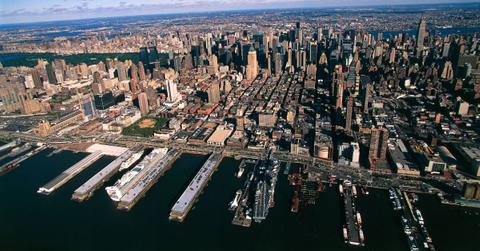Going, Going, Gone? Experts Warn New York City, Areas of East Coast Sinking into Sea

The United States East Coast is sinking at an alarming rate, posing a "major threat" to densely populated cities, according to new research.
Jan. 17 2024, Published 1:01 p.m. ET
New research reveals that parts of the East Coast of the United States are sinking into the sea at an alarming rate, posing a significant threat to densely populated cities and critical infrastructure.
A study conducted by researchers from Virginia Tech and the U.S. Geological Survey indicates that certain areas along the Atlantic coast are experiencing subsidence, or the gradual lowering of land, at a rate higher than the global rise in sea levels.
Cities such as New York City, Long Island, Baltimore, Virginia Beach and Norfolk are particularly vulnerable, with potential risks to roadways, airport runways, building foundations, rail lines and pipelines, according to the study published in Proceedings of the National Academies of Sciences recently.
The high population density and concentration of assets in these coastal regions amplify their exposure to climate change impacts and associated uncertainties, the study suggests.
Utilizing data from space-based radar satellites, the researchers identified specific areas on the East Coast where land is sinking and assessed potential future impacts on populations, assets and infrastructure.
The study reveals that a substantial portion of the East Coast is sinking at a minimum rate of 2 mm per year, with a 1,400-square-mile area experiencing a retreat of more than 5 mm annually — surpassing the current global sea level rise of 4 millimeters per year. This phenomenon affects up to 2.1 million people and 867,000 properties.
- What Lies Beneath: NASA Scientist Believes Aliens May Have Found 'Perfect' Hiding Spot in Earth's Oceans
- Global Threat: Russia Insider Warns West of 'World War Using Nuclear Weapons' Amid Escalating Support for Ukraine
- Countdown to Disaster? Ex-NATO Official Warns Russia, Iran and China Could Wage WWIII in Just Years
The study emphasizes that the sinking of the land is not an “intangible threat” and highlights the impacts on individuals.
Manoochehr Shirzaei, an associate professor at Virginia Tech and a researcher on the study, underscores that this phenomenon affects everyone and, while gradual, has real consequences. Leonard Ohenhen, a graduate student involved in the study, warns that the potential consequences are worsened by the dense populations of these areas.
Never miss a story — sign up for the Front Page Detectives newsletter. Be on the scene the moment news breaks.
The study identifies airports and railway systems as critical resources affected by subsidence rates exceeding 2 mm per year, potentially leading to damage and increased flood risks. Ohenhen emphasizes the need for concern regarding “continuous unmitigated subsidence on the U.S. East Coast.”
In light of these findings, the study suggests that the data can be valuable for coastal disaster resilience planning. The researchers stress the necessity for a “targeted approach in transitioning from reactive to proactive hazard mitigation strategies in the era of climate change.”
Become a Front Page Detective
Sign up to receive breaking
Front Page Detectives
news and exclusive investigations.
